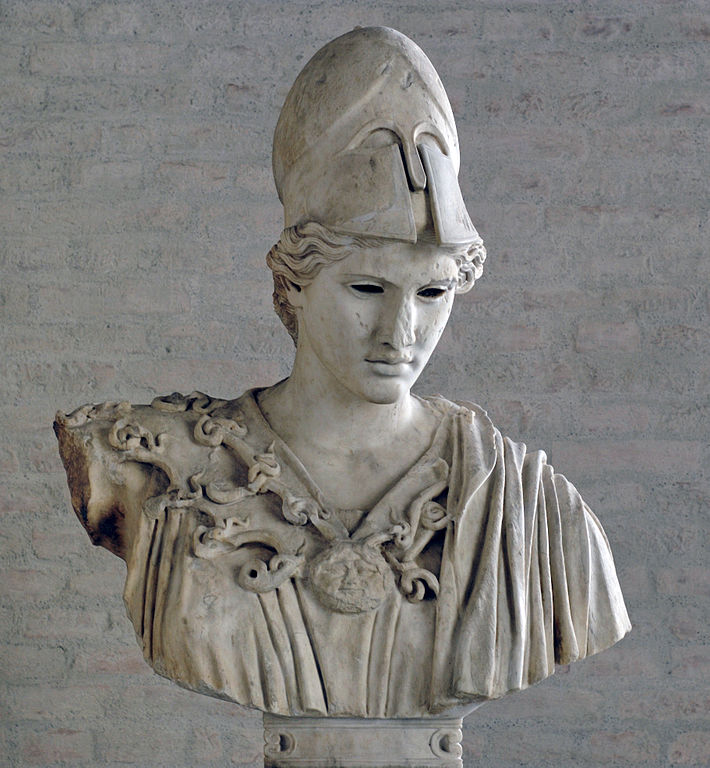Athena (Minerva)
Athena, also referred to as Athene, is the Olympian goddess of wisdom, handicraft and war and the adored patroness and protectress of the city of Athens. In her role as protector, she was also revered in many other major cities, notably as patron of Sparta, as the founder of Thebes in Boeotia, and at Corinth where she appeared on the city’s coins. She was essentially urban and civilized, the antithesis in many respects of Artemis, goddess of the outdoors.
The Birth of Athena
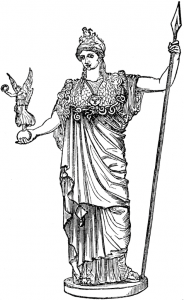
In Hesiod’s “Theogony” you can find the story of her birth.Athena was born in most miraculous circumstances. After Zeus acquired dominion in Olympus, he united with Metis the goddess of prudence and thought. The child to be born from this union was said to overthrow Zeus. Just when Metis was about to deliver baby, Zeus swallowed it. Before long, however, he began suffering an intense headache. To appease this unbearable headache, he ordered Hephaestus the blacksmith god to cleave his head with an axe. Fullfilling Zeus’s order, Hephaestus did so, and Athena aprang out of clevage in his head, well equipped with arms. Athena leapt out of Zeus’ head, fully armed and with a cry so mighty and fearsome that Uranus and Gaea were shaken to their bones with terror.
Goddess of war
She took her place in Olympus along with the other deities. Athena, who was
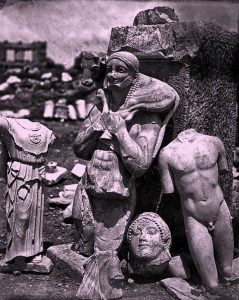
the personification of subtle mind, craftiness and thinking, was the contrast of Ares in Olympus, as the goddess of rightfull war. And, because Zeus favored Athena the most among his childrem, he gave his shield and flaming thunderbolt to her only. Athena was probably a pre-Hellenic goddess and was later taken over by the Greeks. Yet the Greek economy, unlike that of the Minoans, was largely military, so that Athena, while retaining her earlier domestic functions, became a goddess of war.
Not even the war god Ares knew war tricks as well as she did. She also invented many tools and musical instruments and taught people how to use them It was announced that the city of Athens was going to be given to a deity who would be most beneficial. Athena’s moral and military superiority to Ares derived in part from the fact that she represented the intellectual and civilized side of war and the virtues of justice and skill, whereas Ares represented mere blood lust. A competition was launched fort his purpose, wherby Poseidon spurted sea water from the ground and Athena’s deed was more beneficial and thus left the patronage of Athens to her.
Pallas Athena
This came as no surprise because Athena as the goddes of prudence, was
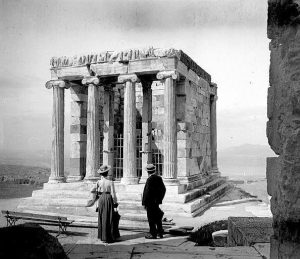
quick to reckon a more beneficial way due to her ingenuity. As a divine maiden, she was also the impression of virtue. Homer refers to her as the grey-eyed Pallas. Her being named as Pallas during could have been because she killed the giant named Pallas during the was against the giants. Athena stripped off the skin of the giant and made herself an aegis from it. The sculpture of Pallas Athena was assumed to have maical attributions and was named Palladium.
Athena Polias
Athena was also called by many names other than Pallas. For example,
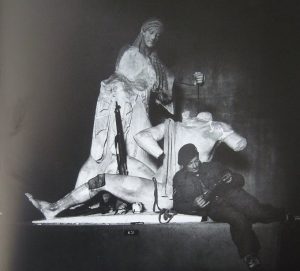
Promachus, meaning the one who fights on the front line; Polias, due to her guardianship of cities, Parthenos, due to embodiment of virginhood, and Proonea, as the symbol of wisdom, were among these names. Her depiction in the Iliad is more like a war goddess. Her emergence there as city goddess, Athena Polias (“Athena, Guardian of the City”), accompanied the ancient city-state’s transition from monarchy to democracy. On every occasion, she protects the Achaeans and plots schemes against the Trojans. It is not clear wheather this bias was because she was the guardian goddess of the city of Athens, or due to a feminine grudge against Paris of Troy for not choosing her as the most beautiful among the goddess.
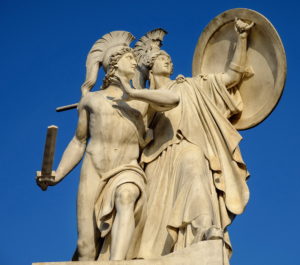
Homer’s Iliad portrays her as an obnoxious, trickster and violent war goddess, while she is seen more as an amiable goddess in the Odyssey, symbolizing prudence and knowledge. She also gave protection to Odysseus and is credited with giving him the idea of the Wooden Horse Both Homer and Hesiod refer to Athena as ‘bright-eyed’ and ‘Tritogeneia’. She is also frequently called ‘goddess of spoil’, the ‘lovely-haired goddess’, and ‘Alalkomenaian Athena’. Athena appears in Homer’s Odyssey as the tutelary deity of Odysseus, and myths from later sources portray her similarly as helper of Perseus and Heracles (Hercules). In the course of the Trojan War, she struck Ajax with madness.
As a goddess of war, Athena often appears in Greek legend to assist various heroes like Heracles, Odysseus, and Jason.
Hymns to Athena
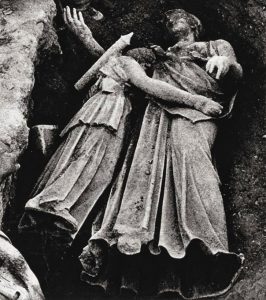
Homer’s “Odyssey” is an invaluable source for Athena and her deeds. Homer wrote a hymn in Athena’s honor. If you want something briefer, read “The Homeric Hymns to Athena” (11 and 28)
I begin to sing of Pallas Athena, the glorious goddess,
bright-eyed, inventive, unbending of heart, pure virgin,
saviour of cities, courageous, Tritogeneia.
From his awful head wise Zeus himself bore her
arrayed in warlike arms of flashing gold,
and awe seized all the gods as they gazed.
But Athena sprang quickly from the immortal head
and stood before Zeus who holds the aegis, shaking a sharp spear:
great Olympus began to reel horribly at the might
of the grey-eyed goddess, and earth round about cried fearfully,
and the sea was moved and tossed with dark waves,
while foam burst forth suddenly:
the bright Son of Hyperion stopped his swift-footed horses a long while,
until the maiden Pallas Athena had stripped
the heavenly armor from her immortal shoulders.
And wise Zeus was glad.
Hail to you, daughter of Zeus who holds the aegis!
Virgin Athena
Emulously protecting her virginity, Athena was at the same time very fond of
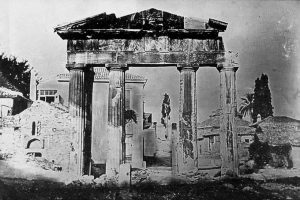
her beauty. One day, she saw her reflection in the water while playing the pipe (aulos), supposedly her own invention, and realized how ugly this rendered her and threw it away and walked away. Marysas, who later found this pipe and became adept at palying it, was to suffer many incidents. Athena was also the inventor of the war chariot drawn by four horses and the mastermind in the building of the ship Argo. In some older stories, Athena is connected as either the mother or adoptive mother of Erichthonius, after an attempted rape by her brother, Hephaestus. In some versions of the story, she is a virgin mother, who raised Erichthonius after he was given to her by Gaia.
Athena contested against Poseidon the god. She also competed with a mortal name Arachne, who was famous for her excellence in weaving and was from the town of Colophon near Ephesus. She was particularly known as the patroness of spinning and weaving.
Athena is generally seen her statues as armed from top to shoe. She is seen as holding her shield in one hand and a aspear in her other hand, while wearing a headpiece. Her shield and her breastplate bear the head of Medusa on them. Some of her statues depict her as the embodiment of virgin beauty; serious, prudent and unarmed.
In Art
Two Athenians, the sculptor Phidias and the playwright Aeschylus, contributed significantly to the cultural dissemination of Athena’s image. She inspired three of Phidias’ sculptural masterpieces, including the massive chryselephantine (gold and ivory) statue of Athena Parthenos housed in the Parthenon At the Temple of Parthenon, which was dedicated to Athena, there was a sculpture of the goddess created by Phidias at a height of 9 meters from gold plated ivory. In front of the same temple, the bronze statue depicting her as the ‘frontline fighter’ was also cast bu Phidias. Unfortunately, these exquisite Works of art from the Antiquity have disappeared now, but their Roman copies at the Athens Museum can give an idea. There are replicas of originals such as of Athena Medici and Athena of Velletri dating approximately to 440-430 BC in Paris; Athena Albani dating approximetely to 440 BC in the Villa Albani in Rome; Athena Giustiniani dating to 400 BC’s in he Vatican Museum, Ince Athena dating to around to 400 BC in Liverpool, and Athena Hope dating to late 5th century BC in Naples. In Turkey, there are statues of her in the Istanbul Archaeology Museums and Antalya Museum. Her symbols are spear, shield and aegis.
Her shield bore the head of the gorgon who transformed every onlooker to stone and was killed by Perseus.Her favorite animal was owl and favorite plant was olive. Goddess Athena was also treated in other branches of art. On vase illustrations, Athena’s birth from the head of Zeus and Hephaestus’s cleaving Zeus’s head with an axe are featured. She was associated with birds, particularly the owl, which became famous as the city’s own symbol, and with the snake.
Athena was recognized as Minerva in Rome. She was also called by the name Nike. Nike, the goddess who personified victory, was known to be the play mate of Athena. Even though Nike belongs with pre-Olympian deities, she was mostly associated with Athena. For example, the temple of Nike in Athens was assumed to be of Athena. She is also depicted carrying a shield bearing the head of the Gorgon. Because of her association with wisdom, Athena is usually shown with an owl nearby
One of the most well-known libraries of the ancient times after the Library of Alexandria was the one in Pergamum. This library, which is situated neard the temple of Athena, has a massive sculpture of the goddess Athena. The library was devoted to Athena. She was also reverred as the chief deity in Troy, and a top-hill temple was built there for her. Unfortunately, this temple was destroyed during the excavations uncaringly carried out by Schliemann.
Temple of Athena
The Temple of Athens built at the acropolis of Assos in 530 BC, retains its ancient beauty. Many parts of this temple are at the ıstanbul Archaeology Museums today. In Priene, there is an Ionic-order temple of Athena which was built by Pytheos the architect in the 4th century BC, with 6 x 11 columns and measuring 19.55 x 37.20 m. The eastern part of this temple was commissioned by Alexander the Great.
Furthermore, from the Temple of Athena in Pergamum, only the location of which can be discerned now, the propylon was dismantled and brough to Berlin and was re-assemled there at the Berlin Museum. The Temple of Athena at Heracleia, with its striking dispaly reflected on the blue waters of Lake Bafa, has it walls still standing today. There are also other temples of Athena in Anatolia such as those in Side, Smyrna, Miletus, Phocaea and Erythrae.
Cult of Athena
The cult of Athena was experienced in Athens in its most intriguing form. The festival included a magnificent procession through the city, the presentation to Athena of a specially woven peplos (depicting the Gigantomachy), and athletic games. Prizes for the games were amphorae painted with a figure of Athena and contained prime olive oil. The Panathenaic festival held to honor the goddess was an important event in a cultural, religious and artistic sense. Hence, the most important temples of her are to be found in Athens. The largest temple of Athena is the Temple of Parthenon constructed on the northern flank of the Acropolis of Athens. This temple which remains standing today in all its splendor, was created by architects Iktinos and Kallikrates. It began to be build in 447 BC, and was completed in nine years. Its decorations, which can still be partialy seen today, took six years. It has seventeen columns on the sides and eight of them on the front and back. On the South eastern corner of the Acropolis hill, across from this grandoise temple is the Temple of Athena Nike which survives to this day intact. The temple has embossments on it describing Greco-Persian wars and was built around 427-424 BC.
The most beautiful and largest of the temples in the Peloponnese is the Temple of Athena Alea in Tegea from the 4th century BC. Representing a blend of Doric, Ionic and Corinthian orders, the temple remains standing today, thoughdamaged. Its architect was reportedly Scopas. The Temple of Athena Aphaea on the island of Aegina near Athens, which dates to the 5th century BC, is spectacular looking. This temple respresents an association with the local god Aphaea. The third temple near the temples of Hera in Paestum in Italy is assumed to have been devoted to Athena.

